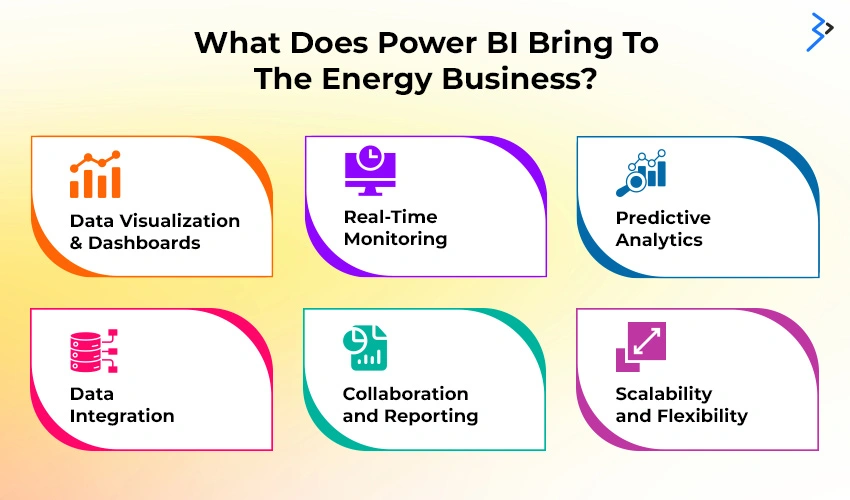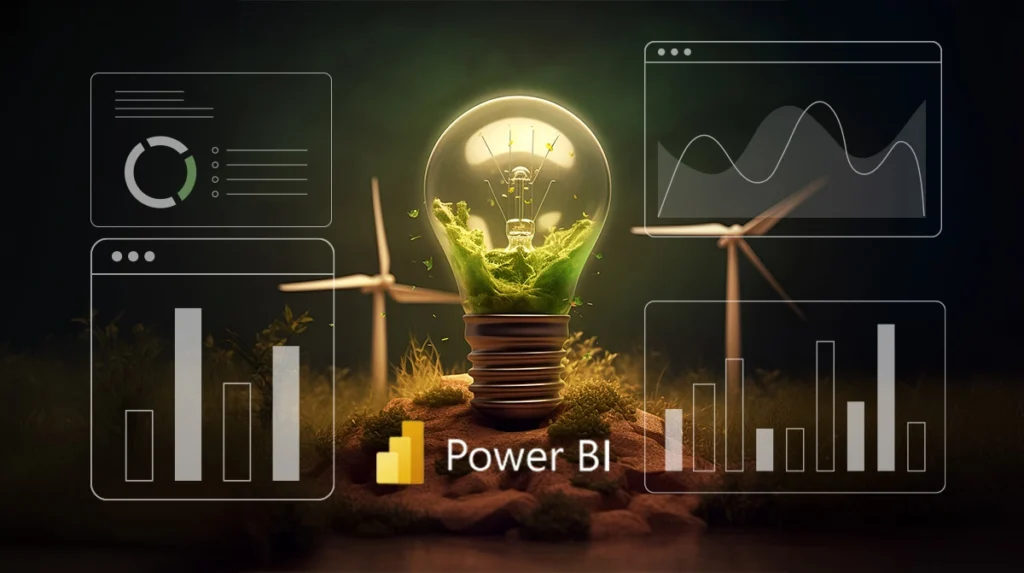The energy sector is driven by the relentless pursuit of efficiency, sustainability, and innovation.
The constant tussle to produce cleaner energy faster at scale requires analyzing enormous amounts of data. A data analytics tool promises to turn the energy business’s complex data landscape into a clear, actionable roadmap. Microsoft Power BI – a powerful data visualization tool that picks patterns of past data, analyzes current energy trends and gives a peek into the future.
54% of enterprise leaders believe Power BI is crucial to their business’s current and future initiatives and strategy. Power BI is a major component of Microsoft Fabric, primarily used for data visualization and reporting needs.
Power BI is capable of creating waves in the energy sector, and here’s how you can unlock its full potential:
Why Power BI for the energy sector?
With vast amounts of data generated daily from various sources, managing and making sense of this data can be overwhelming. Power BI is a comprehensive data analytics tool that offers solutions tailored to the unique needs of the energy sector. Its ability to transform raw data into insightful visualizations makes it an indispensable asset for energy companies aiming to enhance their decision-making processes and operational efficiency.
Energy companies are often challenged to make critical decisions based on a complex data web. The volume and variety of data can obscure the bigger picture, from production metrics and consumption patterns to maintenance schedules and financial reports. Power BI addresses this challenge by providing a platform that consolidates data from multiple sources, enabling energy companies to visualize and analyze their data more effectively. This facilitates better decision-making, strategic planning, and resource allocation.
Power BI’s real-time data processing capabilities benefit the energy sector. Monitoring operations in real-time allows for immediate responses to anomalies or issues, reducing downtime and increasing productivity. Furthermore, Power BI’s integration with popular Microsoft tools, such as Microsoft 365 and Azure, enhances its functionality, making it easier for energy companies to leverage their existing data infrastructure.
What Does Power BI Bring To The Energy Business?

Power BI integration eliminates several challenges of gathering, processing, and assessing data for energy companies. The platform helps alleviate some pressing needs, including identifying patterns in usage, mitigating failures, predicting risks, and addressing problems in real time. Partnering with an AEM partner solutions provider can further enhance data-driven decision-making by integrating seamless content management and personalized digital experiences. Here are some more capabilities of Power BI with Big Data:
- Data Visualization and Dashboards
Power BI provides interactive dashboards that offer a comprehensive view of operations. Users can create custom visualizations to track key performance indicators (KPIs), energy consumption, and production efficiency optimization.
- Real-Time Monitoring
Real-time data processing allows for immediate insights into operational performance. This is crucial for managing supply and demand, identifying inefficiencies, and optimizing resource allocation.
- Predictive Analytics
Power BI’s advanced analytics capabilities enable energy companies to predict future trends and make informed decisions. Predictive maintenance, for example, can help prevent equipment failures and reduce maintenance costs.
- Data Integration
Power BI seamlessly integrates with various data sources, including IoT devices, SCADA systems, and ERP software, ensuring a unified view of data across the organization.
- Collaboration and Reporting
Power BI supports mobile-optimized reports and has a mobile app. SelectHub has an analyst score of 100/100 for Power BI reports that fit on any screen, even in low connectivity.

With Power BI, teams can collaborate more effectively by sharing dashboards and reports. This promotes transparency and ensures that everyone is working with the same data.
- Scalability and Flexibility
Power BI’s cloud-based platform offers business intelligence scalability, allowing energy companies to handle increasing data as they grow. Its flexible design also allows for customization to meet specific business needs.
Power BI vs. Traditional Data Management
| Aspect | Traditional Data Management | Power BI |
| Data Access | Limited to specific departments | Unified access across the organization |
| Real-Time Monitoring | Often unavailable | Available |
| Predictive Analytics | Requires specialized tools | Integrated |
| Collaboration | Siloed, difficult to share | Easy sharing and collaboration |
Things to do to Maximize Energy Data
Brainvire Infotech specializes in helping energy companies unlock the full potential of their data using Power BI. Our data analytics and business intelligence expertise ensure you get the most out of your investment. Here’s how we can assist you:
- Get your customized roadmap
We start by understanding your specific needs and challenges. Our team then creates a customized roadmap outlining the steps to implement Power BI effectively. This includes identifying key data sources, setting up dashboards, and defining KPIs.
- Data Integration and Visualization
Our implementation process is designed to be seamless and efficient. We handle the technical aspects of setting up Power BI, along with dashboard creation, data integration, and user training. Our goal is to ensure that your team can start using Power BI to its full potential as quickly as possible.
- Technical support
We offer comprehensive technical support to ensure your Power BI solution consistently aligns with your evolving needs. Our dedicated support team is equipped to resolve issues, implement updates, and deliver tailored training sessions as required.
Comparison benefits before and after implementing Power BI with Brainvire’s assistance:
| Benefit | Before Implementation | After Implementation |
| Data Accessibility | Isolated systems, difficult to access | Centralized access, easy to retrieve |
| Decision Making | Based on fragmented data | Informed by comprehensive, real-time insights |
| Operational Efficiency | Limited by manual processes | Enhanced through automation and analytics |
| Maintenance Costs | High due to reactive maintenance | Reduced with predictive maintenance |
| Collaboration | Siloed and inefficient | Improved with shared dashboards and reports |
Takeaway
The ability to harness and interpret vast amounts of data has become a critical differentiator for the energy vertical for digital transformation. By partnering with Brainvire Infotech, energy businesses can leverage Power BI’s full capabilities, ensuring they stay ahead in an increasingly data-driven industry. Whether through real-time monitoring, predictive analytics, or enhanced collaboration, Power BI can help your energy company achieve greater efficiency, productivity, and profitability.
FAQs
Power BI is an interactive data visualization platform that can aid the energy sector in predicting changes in demand, overloads, and possible anomalies to handle these situations more proactively. With the constant increase in energy demand, the sector can improve forecasting, production, and management by correctly implementing Power BI.
Power BI enables real-time energy consumption monitoring by integrating with various data sources. It consolidates this data into interactive dashboards, allowing energy companies to visualize consumption patterns, detect anomalies, and make immediate adjustments to optimize energy management.
Power BI leverages advanced analytics and machine learning to predict equipment failures before they occur. By analyzing historical data and identifying patterns, Power BI helps schedule maintenance activities proactively, reducing downtime and maintenance costs and extending the lifespan of critical equipment.
Power BI facilitates renewable energy integration by analyzing data from various renewable sources, such as solar, wind, and hydro. It helps forecast energy production, assess grid impact, and optimize resource allocation, ensuring a balanced and efficient integration of renewable energy into the existing grid.
Yes, Power BI simplifies regulatory compliance reporting by automating data collection and report generation. It ensures accuracy and consistency in reporting, helping energy companies meet regulatory requirements efficiently. Customizable dashboards and reports make it easier to demonstrate compliance with regulatory bodies.
Power BI aids in cost reduction by providing insights into operational inefficiencies and identifying areas for cost savings. It analyzes data across various parameters such as energy consumption, production costs, and maintenance expenses, enabling energy companies to implement cost-effective strategies and improve overall financial performance.
Power BI enhances grid stability analysis by providing real-time data on grid performance, load balancing, and fault detection. It enables energy companies to monitor grid conditions continuously, anticipate issues, and implement corrective actions promptly, ensuring a stable and reliable energy supply.
Power BI tracks sustainability metrics by integrating data from various sources related to emissions, energy efficiency, and resource utilization. It provides detailed reports and dashboards that help companies measure their sustainability efforts. Additionally, Power BI analyzes customer data to offer insights into consumption patterns and preferences, enabling better customer engagement and service.
Yes, Power BI is designed to integrate seamlessly with existing IT infrastructure. It supports many data sources and systems commonly used in the energy sector, such as ERP systems, IoT platforms, and cloud services. This integration capability ensures a smooth transition and maximizes the value of existing data investments.
Energy companies can implement Power BI by partnering with experienced providers like Brainvire Infotech. The process begins with a needs assessment to understand specific requirements, followed by developing a customized implementation roadmap. Brainvire handles the technical setup, data integration, and dashboard creation and provides ongoing support to ensure successful adoption and continuous improvement.
Related Articles
-
7 Organizational Advantages of Using Microsoft SharePoint
Do you still use a complex, out-of-date legacy system to organise your company files? If this is the case, your team isn’t getting the most out of SharePoint and isn’t
-
Microsoft PowerApps: How Enterprises Are Racing Towards Digital Transformation in Top Gear!
Microsoft PowerApps. Your enterprise might have already started using it. If not, this blog will give you all the reasons to do so right away. Speaking about this article, your
-
Microsoft SharePoint 2019: What’s new?
Ever since Microsoft launched its web-based collaborative platform SharePoint in 2001, there has been constant innovation in the process. The latest unveiling is that of the SharePoint Server 2019, which




